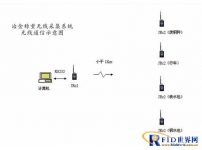
Low-cost industrial automation wireless data transmission solution
[ad_1]
Wireless communication technology can improve the bandwidth of wireless data link and flexible network topology for communication between various intelligent field devices, mobile robots and various automation equipment in the factory environment, which can effectively make up for it in some special environments. The deficiencies of the wired network further improve the communication performance of the industrial control network.
The company’s JRC6 is an embedded module with ultra-low power consumption, low cost, working in a license-free frequency band, suitable for industrial and enterprise users to establish short-distance, high-reliability data transmission requirements. The unique Ad-hoc network technology of the module provides a fast and reliable wireless network for the transmission of important data, allowing users to establish a fully adaptive, upgradeable, and expandable application system. The maximum power of JRC5 is 500mW, and it can be built around 1000 meters (using 1.5dbi gain omnidirectional antenna), a highly reliable data transmission network, through the combination of JRC5 and JRC6, it can form a low-cost, high-efficiency, and convenient industrial automation wireless data acquisition system .
The JRC series modules work at 915MHZ and are mainly used in metallurgy, mining, petroleum refining and chemical, power monitoring and other industries. Due to the large obstacles in many industrial field environments, the 2.4G ZIGBEE module cannot overcome the obstacles, making it difficult for the ZIGBEE system to meet the requirements for field use; for the common 433m wireless module, it is just a simple inheritance, which cannot solve wireless collisions and data well. Routing and other issues.
Using the JRC6 module, you can do a lot of node, burst wireless data acquisition system, through the combination with JRC5, you can achieve long-distance low-cost data acquisition program examples. As shown below:

JRC5 is the routing node of the network. It can also be used as a wireless access point for sensors. Users do not need to configure any routing information for JRC5. Users use the wireless module’s data transparent transmission mode, user-defined communication protocols, data formats, etc. The JRC6 module is a stamp-style patch package, which can be well integrated into the instrument and meter to create an excellent wireless sensor. If the distance between the user terminal and the site is greater than 1KM, the JRC5 can be added to realize the long-distance transmission of data with the freedom of application modules to form a full-coverage wireless sensor network.
Technical features:
1. Reliable communication
The system adopts the collision avoidance mechanism of CSMA-CA to avoid competition and conflict when sending data; adopts a fully confirmed data transmission mechanism to ensure the reliability of information transmission;
2. The network has strong self-organization and self-healing capabilities
Self-organizing function: Without manual intervention, network nodes can perceive the existence of other nodes and determine the connection relationship to form a structured network;
Self-healing function: adding, deleting or moving nodes, node failures, etc., the network can repair itself without manual intervention, ensuring that the entire system can still work normally.
3. Controllable cost
Through the Level 2 wireless network, the cost of terminal equipment is effectively reduced.
In addition, the company also has wireless modules with a distance of 2KM, 3KM, and 5KM to meet the needs of different occasions.
[ad_2]



